SHROUD OF TURIN
PICTURE TOUR WITH DR JOHN DESALVO
PAGE 2 of 5
If we study the face, we can
see that the man had long flowing hair, a truncated moustache, a long beard,
and his eyes are closed. There appears to be swellings on the
checks and the bridge of the nose also appears swollen. There are
areas on the forehead which appear to be blood stains.
SLIDE 8
-
Close up of the face
Left
- Negative image (as it appears to the naked
eye) Right - Positive image (as
seen on the negative plate)
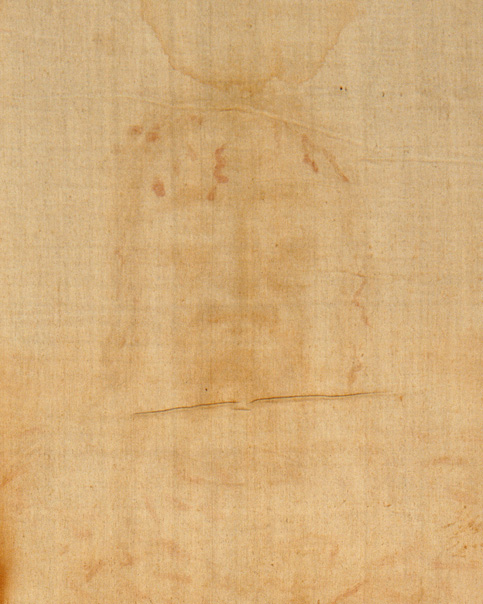
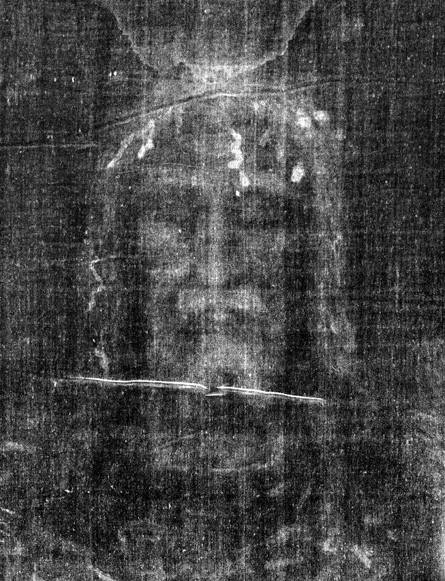
©1978
Barrie M. Schwortz Collection, STERA, Inc.
On this dorsal imprint we
can see the back of the head which is covered with blood stains from puncture
wounds. If these puncture wounds were caused by a crown of thorns,
then the crown was not in the shape of a ringlet as widely believed but in the
shape of a bushy cap which covered the entire head, since the puncture wounds
appear throughout the head right up to the vertex or top.
Also, we can see numerous
marks across the back. These marks appear in the shape of tiny knots or
dumbbells and there are over 100 of these marks occurring in groups of two's
and three's covering the entire body. These marks are likely the result
of some type of scourging. From studying the size and shape of these
marks and historical records we can identify the scourging instrument as the
Roman Flagrum. This instrument has been found in archeological digs and
is shown in Figure 10.
We can also see in the
regions of the shoulder blades quadrangular (four sided) bruises caused
by an object that medical experts estimate would have weighed between 80-100
pounds. The entire cross consisted of an upright portion which remained
in the ground at the sight of crucifixion and a cross bar which was later
attached. Victims of crucifixion only carried the cross bar and not the
entire cross. Since the bruises are over the scourging, this indicates
that the person was first scourged and then made to carry the cross bar of a
cross.
SLIDE 9
- Dorsal (or back) imprint
Left - Back imprint
(negative image) Center - Back imprint (positive
image) Right - Area in white box enlarged (negative
image)
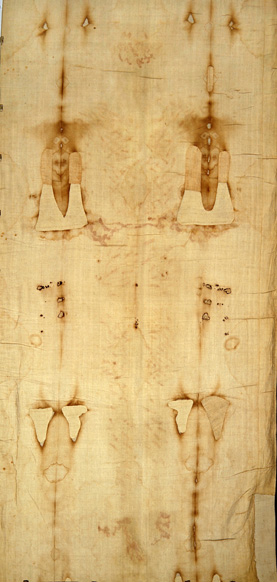
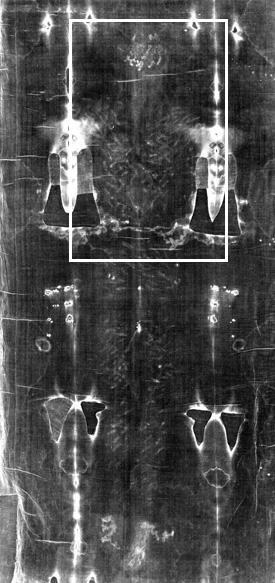
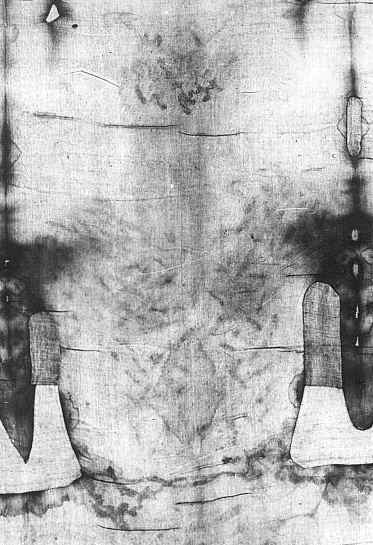
©1978
Barrie M. Schwortz Collection, STERA, Inc.
©1931
Giuseppe Enrie
This instrument was used in
the First Century by the Romans to scourge their victims. It consisted
of a wooden handle with 2 or 3 straps and at the end of these straps were
small lead balls. This instrument would break the skin and cause a deep
and extremely painful bruise. We can deduce by the angles by which the
marks radiate on the Shroud that two people scourged this person, one on the
left and one on the right. In fact, the person on the right was
taller than the person on the left.
SLIDE 10
- Roman Flagrum used for scourging
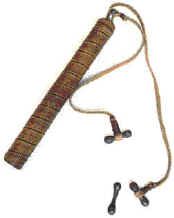
This frontal image shows the
forearms, wrist, and hands. There appears to be a large puncture wound
on the wrist. This is significant because if nails were placed
through the palms of the hand, this would not provide sufficient support to
hold the body to the cross and tearing of the hands would
occur. Only if the nails were placed through the wrists would this
provide sufficient support to hold the body fixed to the cross.
We can also see a large
blood stain and elliptical wound on the person's right side (remember, in a
negative imprint left and right are reversed). From
studying the size and shape of this wound and historical records, we can
deduce that this wound could have been caused by a Roman Lancea. This
lance is pictured in Slide 13.
In addition, by
measuring the angle of dried blood on the wrist, one can reconstruct the angle
at which this person hung from the cross. He mainly hung from a position
65 degrees from the horizontal. But there is another angle of dried
blood at 55 degrees. This shows that this person tried to lift himself
up by 10 degrees. Why? Medical studies show that if a person just
hangs from a position of 65 degrees in would start to suffocate very
quickly. Only if he could lift himself up by about 10 degrees would he
be able to breathe. Thus he would have to raise himself up by this
10 degrees by pushing down on his feet which would have to have been fixed to
the cross. He would then become exhausted and fall down again to the 65
degree position. Thus, he would continue to shift from these two
agonizing positions throughout crucifixion. That is why the executioners
of crucifixion would break the legs of their victims to speed up death.
If they could not lift themselves up to breathe, they would suffocate very
quickly.
SLIDE 11
- Frontal image
Left
- Front imprint (negative image) Center - Front imprint
(positive image) Right - Area in white box enlarged
(negative image)
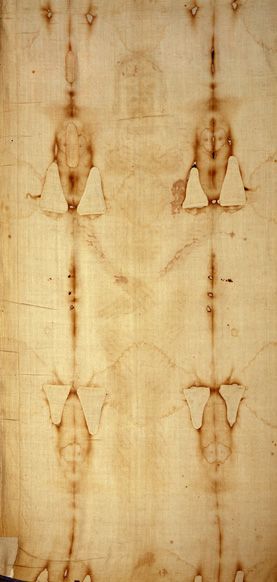

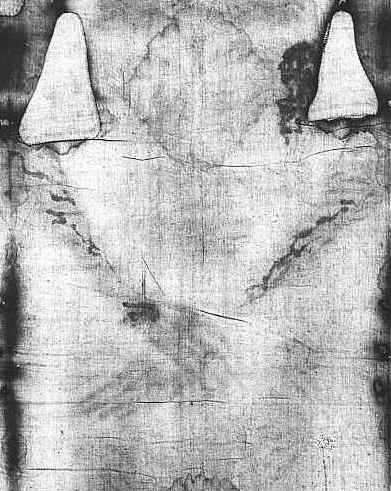
©1978
Barrie M. Schwortz Collection, STERA, Inc.
©1931
Giuseppe Enrie
SLIDE 12
- First Century Nail
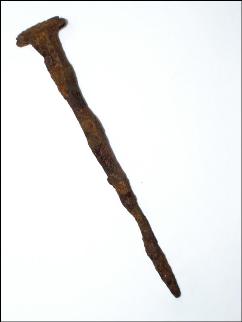
Copyright, Paul C. Maloney,
Ancient Near Eastern Researches
SLIDE 13
- First Century Roman Lancea

On this dorsal image the
imprint of the right foot can be seen. It appears that two nails were
used. One was first placed through the right angle joint and this fixed
the right foot to the cross. Than the left foot was placed over the
right and a second nail driven through the fleshy section of both feet.
SLIDE 14
-
Dorsal image showing the back of the
feet
Left
- Back imprint (negative image) Right - Area in
white box enlarged (negative image)
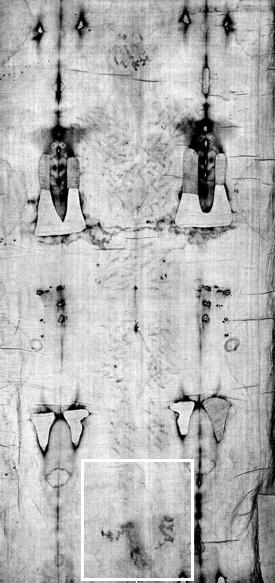

©1931
Giuseppe Enrie
GO TO PAGE
3













